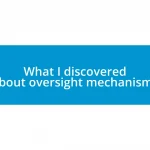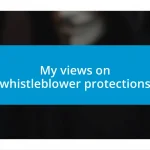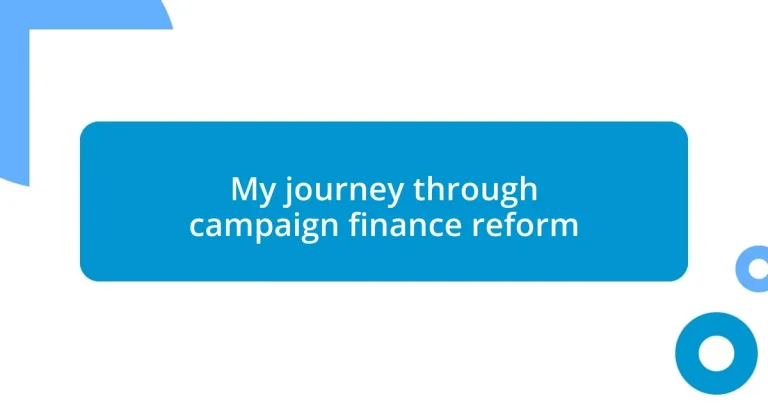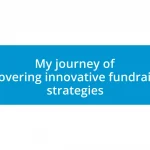Key takeaways:
- Campaign finance reform aims to create a fair political landscape by addressing the influence of money in politics, ensuring all voices are represented.
- Key legislation such as the Bipartisan Campaign Reform Act and the Citizens United ruling significantly shaped the campaign finance environment, raising concerns about corporate influence.
- Grassroots organizations and collective action are vital for advocacy, demonstrating that community engagement can drive meaningful change in campaign finance reform.
- Successful initiatives like Washington’s I-735 and New York City’s matching funds program showcase effective strategies for leveling the playing field for candidates with limited financial backing.
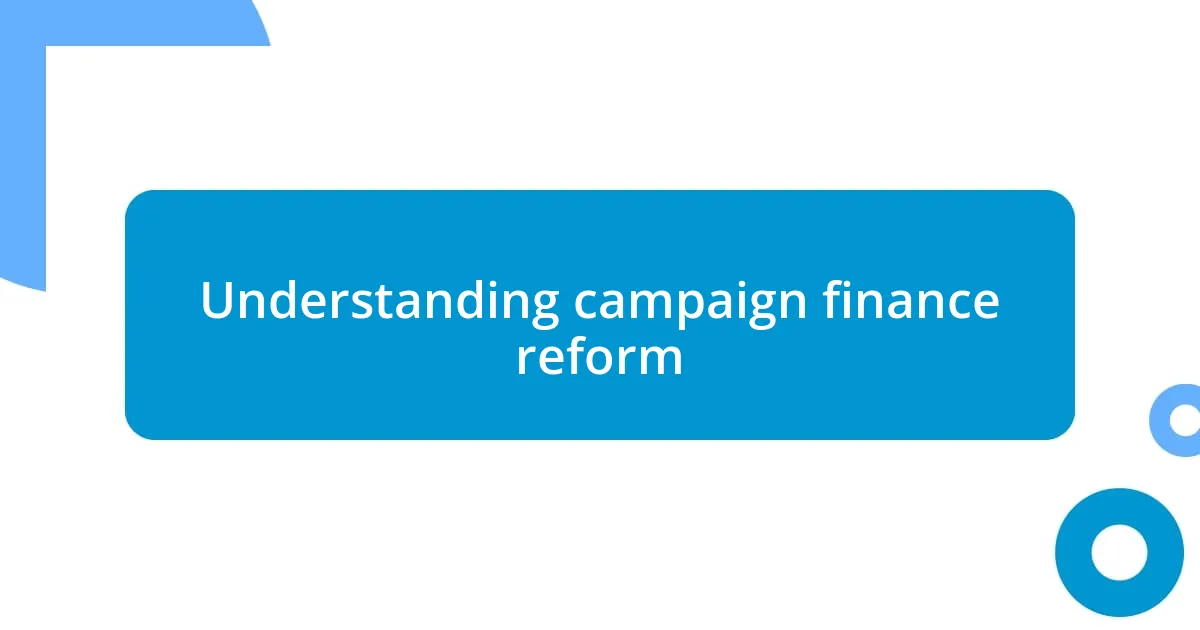
Understanding campaign finance reform
Campaign finance reform is essentially about ensuring that the political playing field is fair. I remember the first time I really understood the impact of money in politics; I watched a local election unfold, with candidates pouring in vast sums just to get their voices heard. It made me wonder: how can we expect true representation when financial power often drowns out regular citizens’ concerns?
The complexity of campaign financing can be overwhelming, and I often find myself pondering how policies can balance the need for free speech—like donating to a favorite candidate—with the danger of corporate influence. In my experience, when I’ve discussed this topic with friends, many express frustration over the sense that their votes feel diluted by the wealth of a few. It’s a reminder of why reform is not just a bureaucratic issue; it’s deeply personal for many of us who care about democracy.
From limits on contributions to transparency in spending, campaign finance reform touches on core values that affect every citizen. Reflecting on my journey through understanding this topic, I’ve realized that each step offers a chance to connect with others who share my concern for a more equitable democratic process. Isn’t it vital that every voice, regardless of wealth, has a fair shot in shaping our future?
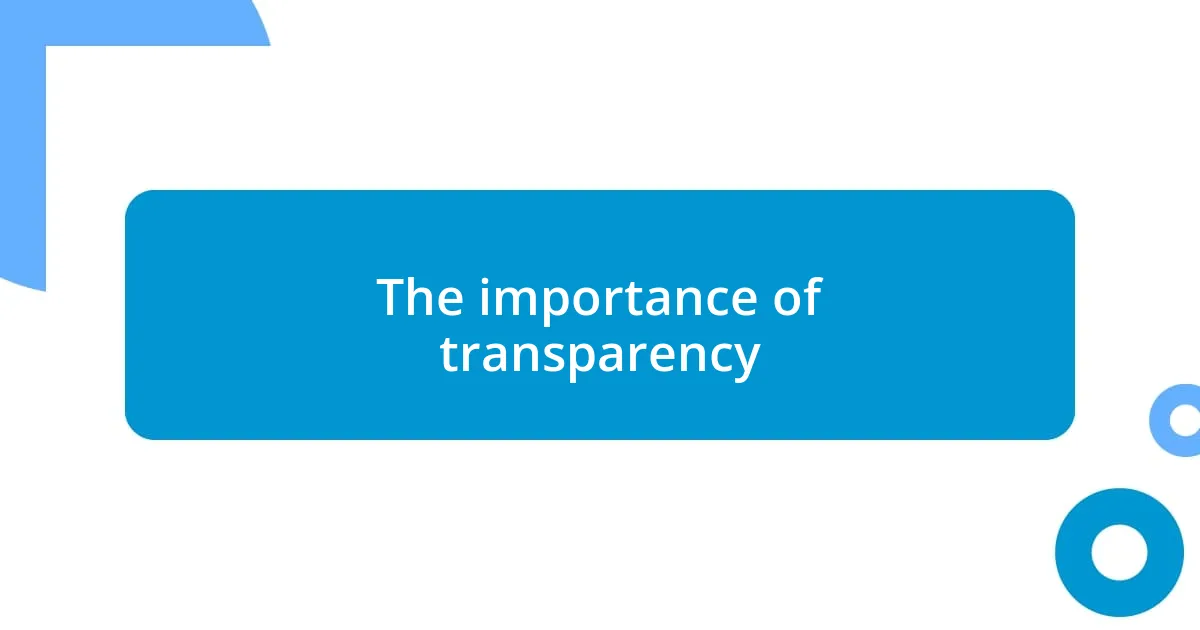
The importance of transparency
Transparency in campaign finance is crucial for a healthy democracy. When I speak with others about this issue, many express their frustration about the hidden money influencing our political landscape. I can recall a poignant moment when a friend, a small business owner, felt disillusioned after realizing that a large corporation’s unnoticed funding could tilt an election outcome, leaving hardworking citizens feeling sidelined.
I remember attending a town hall meeting where candidates were asked directly about their campaign funds. It was enlightening to hear how some hesitated to disclose their sources, while others embraced the opportunity to showcase their financial backers. This experience made it clear to me that transparency isn’t just about compliance; it’s about creating trust with voters. Without openness, how can we expect individuals to feel empowered in a system that seems obscured by shadows?
More than just numbers on a form, transparency fosters accountability. Reflecting back on my own journey, I’ve seen how the more information you provide, the more engaged the electorate becomes. I’ve witnessed firsthand how communities can rally together when they feel they have a stake in the process. When everyone understands who’s funding the campaigns, it levels the playing field, promoting a healthier dialogue among candidates and voters alike.
| Benefits of Transparency | Consequences of Opacity |
|---|---|
| Increased Voter Trust | Reduced Electoral Participation |
| Equal Representation | Influence from a Few Wealthy Donors |
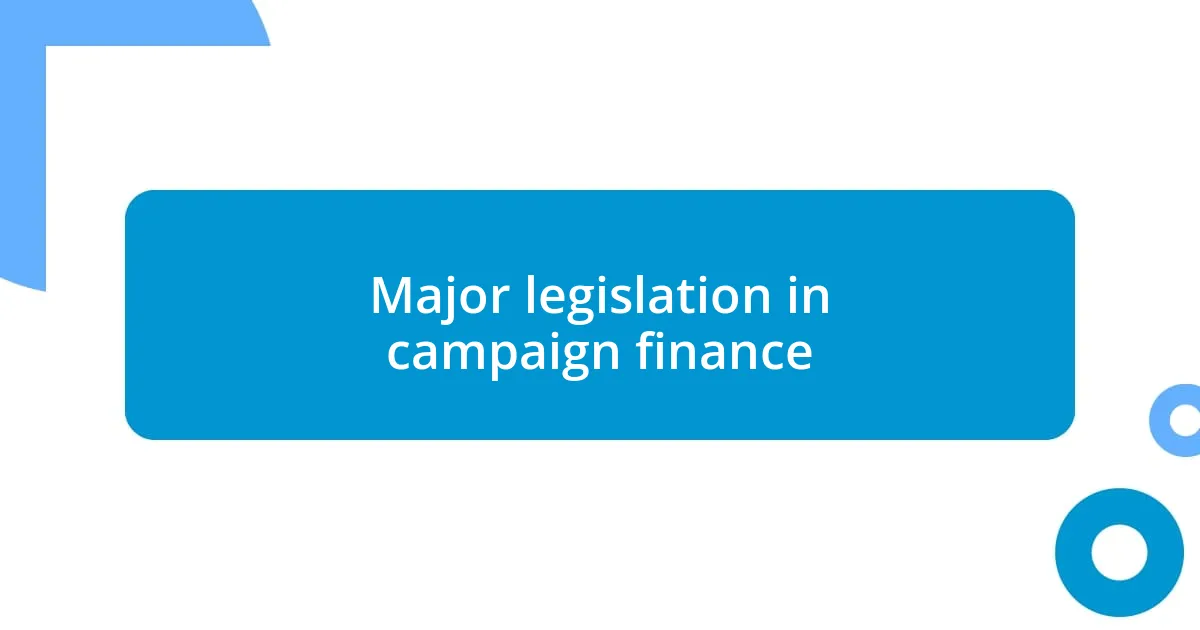
Major legislation in campaign finance
In the realm of campaign finance, several key pieces of legislation have carved the landscape we navigate today. I remember the buzz surrounding the Bipartisan Campaign Reform Act of 2002, also known as the McCain-Feingold Act. This law aimed to limit the influence of soft money—unregulated contributions used for party-building activities—on elections. For many, including myself, it felt like a step towards curtailing the flood of unchecked cash that had begun to inundate our political processes.
As I’ve delved into this topic, I’ve also learned about the effects of the Supreme Court’s Citizens United decision in 2010. This ruling allowed corporations and unions to spend unlimited amounts on independent political campaigns, which left many of us feeling concerned about the sheer volume of money that could now flow freely into elections.
- Bipartisan Campaign Reform Act (2002) – addressed soft money and increased disclosure requirements.
- Citizens United v. FEC (2010) – permitted unlimited independent political expenditure by corporations and unions.
- Federal Election Campaign Act (1971) – established rules for campaign financing, including contribution limits and disclosure mandates.
Reflecting on these legislative milestones, I can’t help but feel the weight of their impact. The discussions I’ve had with friends over coffee often shift to how these laws reflect broader societal imbalances. We’ve shared moments of frustration about how it seems like individuals and lesser-funded candidates face an uphill battle against the tide of money. With each law, I see a dual narrative of hope and anxiety—hope for reform and transparency, but anxiety over the overwhelming challenge posed by corporate interest. It’s a dance that feels both exhilarating and daunting, leaving us all questioning the very essence of our democracy.
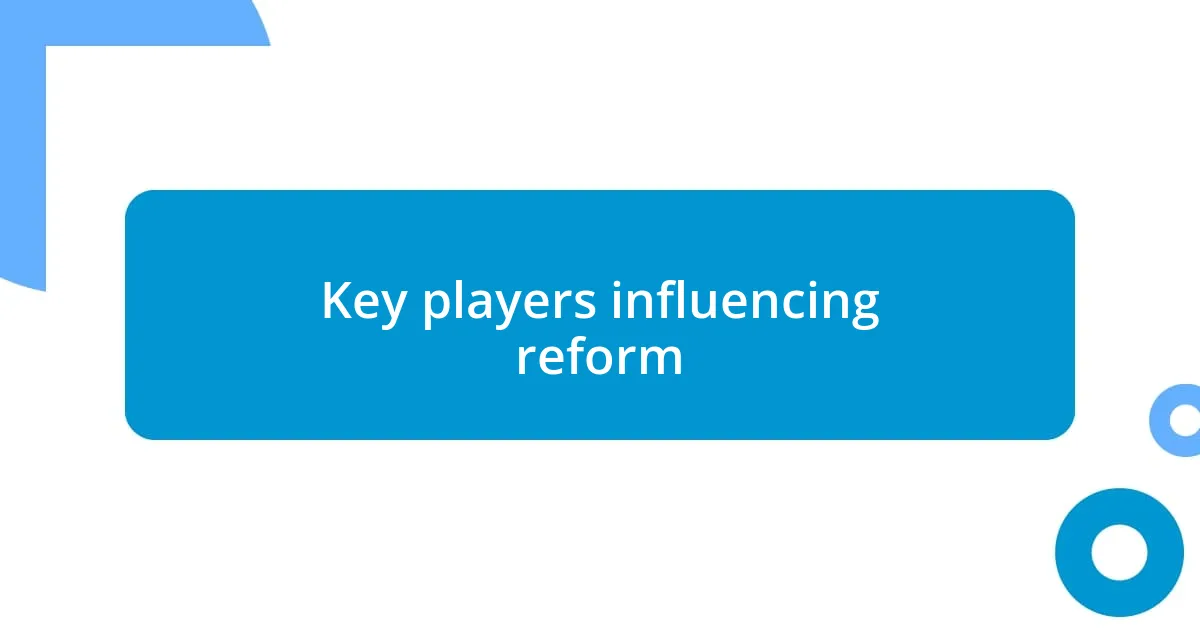
Key players influencing reform
One of the most significant players in campaign finance reform is grassroots organizations. I remember attending a rally organized by a local group advocating for fair election practices. The energy was palpable as everyone shared dreams of a political landscape free from big money. It struck me how these passionate activists not only bring awareness but also mobilize citizens who feel their voices have been drowned out. They serve as a reminder that change often starts at the community level, pushing for reforms that can resonate all the way to the highest offices.
Politicians themselves play a crucial role in shaping the reform narrative. I’ve had some candid conversations with local lawmakers who express a genuine desire for change, yet they often feel shackled by the financial realities of campaigning. When I asked one candidate if they would support stricter donation limits, I could sense the internal struggle—wanting to prioritize their constituents but fearing a financial backlash. This highlights an important question: can we truly expect politicians to champion reform when their campaigns heavily rely on funds from the very systems they wish to change?
Then there are the wealthy benefactors who can be both allies and adversaries in the reform movement. I’ve often pondered the dichotomy of their influence; a friend of mine once described a well-intentioned donor’s efforts to level the playing field as akin to “throwing a pebble into an ocean of money.” It’s intriguing to consider how one individual’s immense wealth can wind up altering the course of local elections. This duality makes me reflect: can genuine reform coexist with high-stakes donations, or is true change only possible when we address the roots of funding inequalities?
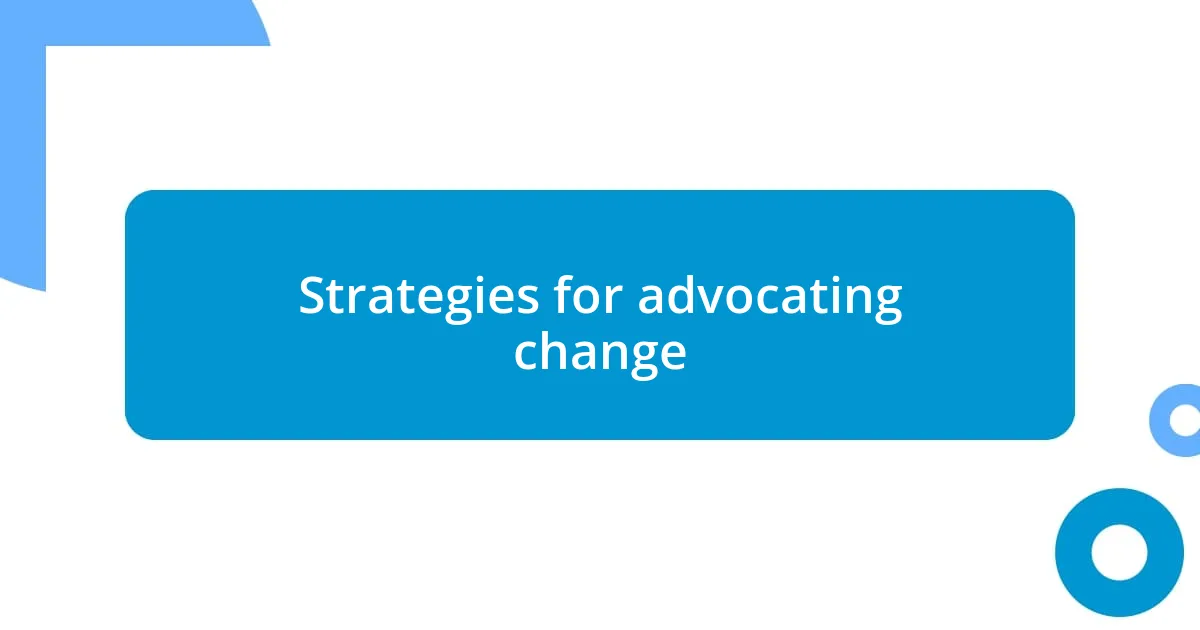
Strategies for advocating change
The backbone of effective advocacy in campaign finance reform lies in building a strong coalition. In my experience, I’ve found that when diverse groups come together—be it from environmentalists to labor unions—they create a united front that is hard to ignore. It’s motivating to see individuals from various walks of life share their stories and illuminate their values, showcasing that we’re all invested in a system that is fair and represents our voices.
Another strategy that has worked for me is leveraging social media to amplify our message. I vividly recall a time I joined a virtual town hall meeting where people shared their thoughts about campaign finance reform. The discussions were vibrant, and the hashtags we created helped our voices reach broader audiences. It made me realize how powerful online platforms can be in rallying support, transcending geographical barriers, and engaging those who might feel disenfranchised by traditional political avenues.
Finally, grassroots fundraising must not be overlooked. Personally, I felt a rush of excitement when I organized a small fundraising event that raised money for a candidate who championed reform. It felt empowering to directly contribute to a campaign that aligned with my values rather than relying on big donors. This experience reinforced my belief: change is truly within our grasp when we shift the focus back to the people and foster a culture of transparency and accountability. Isn’t it amazing how collective action can challenge the traditional power dynamics that often govern our political landscape?
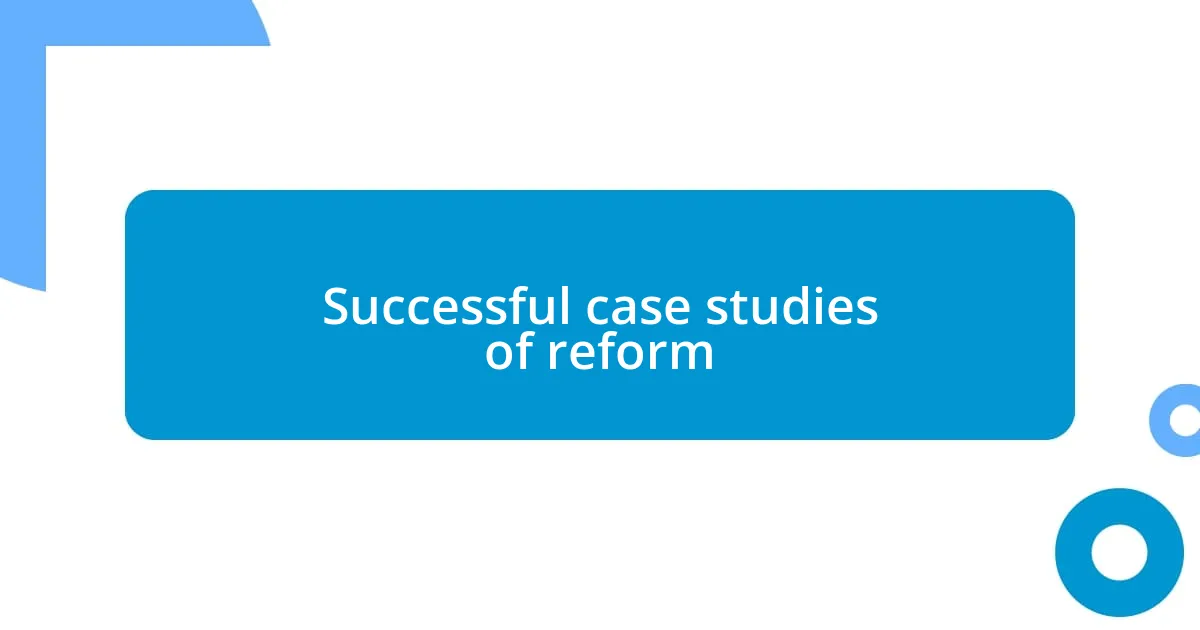
Successful case studies of reform
Transitioning into successful case studies of reform, I can’t help but think about the transformative power of specific initiatives that have made waves across the nation. For instance, when the state of Washington enacted the “I-735” campaign, it was not just an effort to urge Congress to overturn Citizens United; it also served as a rallying cry for citizens. I remember the palpable excitement in the air during community meetings, where people readily shared their hopes for a political system free from the grip of unchecked money. Can you imagine the tides turning when ordinary folks stand up for what they believe in?
Another noteworthy case is the movement in California to establish public financing for campaigns. I recall participating in a discussion with community members who passionately shared their experiences about how access to funding could empower candidates from diverse backgrounds. It struck me as a crucial step toward leveling the playing field, allowing those without deep pockets to compete fairly. Isn’t it fascinating how these democratic measures can inspire latent potential in candidates who have valuable perspectives but lack the traditional donor backing?
Lastly, New York City’s matching funds program exemplifies a successful approach to campaign finance reform. Local candidates receive matching funds for small donations, truly amplifying the voices of everyday citizens. I was inspired when I heard about candidates who overcame significant obstacles in their campaigns, solely due to this initiative. It made me wonder: if we could replicate such a model nationwide, how might that reshape our political landscape? Each success story emphasizes not only the impact of grassroots movements but also illustrates the possibilities for a more equitable political system, one where every voice truly counts.






